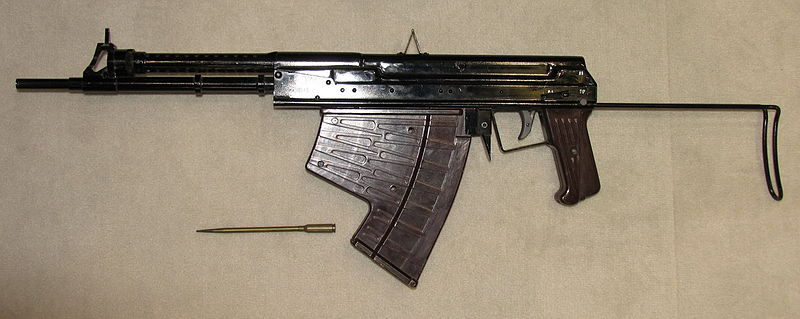The major problem will be overcoming the increased drag at 3 atm. How much increased drag? The drag equation is...
$$F_d = 1/2 \rho u^2 C_d A $$
- $F_d$ drag force
- $\rho$ mass density of the atmosphere
- $u$ velocity of the bullet
- $A$ area of the bullet
- $C_d$ drag coefficient of the bullet
Tripling the atmospheric density will triple the drag. To compensate we have a few choices: more force, less area, less drag.
Brute Force?
We could triple the powder charge while keeping everything else the same, but that will have severe knock on effects for the rest of the gun making it much larger and heavier. Pressure is force / area. If we want to increase the force while keeping the diameter of the projectile (ie. the area) constant we'll need to triple the pressure. Most guns are already operating near their peak pressure, so this will make most guns explode.
For example, your typical 9x19mm pistol round has a maximum pressure of about 240 MPa using about 5 or 6 grains of powder. Now we're asking them to do 720 MPa. 7.62x51mm NATO rifle round asks rifles to handle just 415 MPa.
There's also the question of where to put all that extra powder? The 19mm part of 9x19mm is the length of the round. Triple the powder and you'd have to increase the length of the round increasing the size and weight of the ammunition and all associated parts.
Just adding more bang is a non-starter.
Less Area, More Length, More Density: Flechettes
The ballistic coefficient of a bullet is a measure of its ability to overcome air resistance. A high ballistic coefficient means less drag. There's several ways to calculate ballistic coefficient, but for our purposes we'll use this one:
$$BC = \frac{M}{C_d A} = \frac{\rho l}{C_d}$$
- $M$ is the mass of the bullet.
- $A$ is its area.
- $\rho$ is the density of the bullet.
- $l$ is its length.
- $C_d$ is its drag coefficient.
A more massive bullet is more resistant to drag, but a larger caliber means more area which increases drag.
To increase a projectile's BC we want something long and dense with a lot of mass and low cross-section. We want sub-caliber flechettes. The most extreme example is the APS Underwater "Rifle".

I use quotes around "rifle" because it has no rifling. Instead it fires 5.56mm x 120mm bolts with an effective firing range of 30m at 5m under water.
This is extreme overkill for our 3 atm. The density of water at that depth is 1000 times that of normal air, not the 3 that we're dealing with, but it was such a cool find I had to include it.
There have been any number of flechette weapons in trials over the years boasting higher capacity, higher velocity, and flatter trajectories at a cost of reduced accuracy or more complicated and expensive ways to keep them accurate. Several showed up in the US Advanced Combat Rifle trials in the 1980s.
One was the Steyr ACR firing a sub-caliber 1.5mm x 41mm flechette weighing 10 grains. Unlike the APS, Steyr's weapon had modest rifling to give a slow spin, plus it was fin-stabilized, for accuracy.

Its 10 grain projectile weight was 6 times less than the 62 grains of 5.56mm NATO, but made up for this with its area of just 1.8mm² compared to the 24.3mm² area of 5.56mm NATO: 13.5 times smaller area. Assuming similar density, this could double its ballistic coefficient.
This bears out in its performance. At almost 5000 ft/s, it was nearly 50% faster than the standard 5.56mm NATO with a much flatter trajectory.
The Steyr ACR worked, but ultimately none of the rifles succeeded in being significantly better than the M16 firing 5.56mm NATO. But in a world with triple the atmospheric pressure, flechettes would likely have a great advantage.





